In less than a century, pizza has transitioned from exotic foreign fare to one of the cornerstones of American and Canadian informal (and, increasingly, not-so-informal) cuisine. Many regions have their own pizza traditions with toppings, shapes, and dough styles differing widely.
Understand
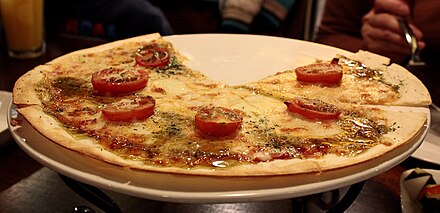
Origins
See also: Italian cuisine
Despite originating in the South of Italy, pizza is one of the most popular dishes in North America and has had a degree of cultural and societal impact that far outstrips most foods. The first people making pizza in North America were Italian immigrants to the United States in the 19th century, but its commercial success wasn't cemented until American GIs returning from Europe after World War II brought with them a taste for Italian flavors. Soon Americans without Italian heritage took to the food and gave it its own unique twists. Almost every town of any size has at least one representative of the large chains and/or independent operators. There is also a lot of regional pride involved in questions of which local variety is preferred, be it Chicago-style "deep dish" pizza or New York style thin-crust pizza.
In addition to replicating earlier pizza styles, North American pizza has some completely different ingredients, toppings, and consistencies than its Italian predecessors. While new delivery food services have made a wider selection of food available in many cities, pizza is one of the few foods that you can expect to be available by delivery almost anywhere in the United States. Pizzerias frequently sell pizza by the slice as well as by the entire pie (although most delivery-only pizzerias do not) and sometimes even in a buffet; they are commonly open late and take orders for takeout and delivery, which often constitute most of their business. As an alternative to pizza by the slice, some pizzerias offer smaller, personal-size pies. Personal pizzas or pizza by the slice are good options for solo travelers.
Toppings
Classic North American toppings include: onions, sausage, peppers, pepperoni, mushrooms, meatballs, salami, olives, spinach (sometimes with ricotta cheese), broccoli, ham, garlic, and extra cheese—common varieties are ricotta, mozzarella, Parmesan, and provolone. White pizzas, without tomato sauce, are also traditional, and it's often possible to get tomatoes as a topping, too. Some pizzerias offer fresh basil as a possible topping, but many do not have it. Anchovies are a family of small fishes traditionally used as a pizza topping but only about 2% of American pizza shops actually carry them, primarily on the East Coast. High-end pizzerias may offer exotic toppings (pine nuts, fresh herbs, etc.) and cater to more specific diets with options such as vegan cheese or gluten-free dough.
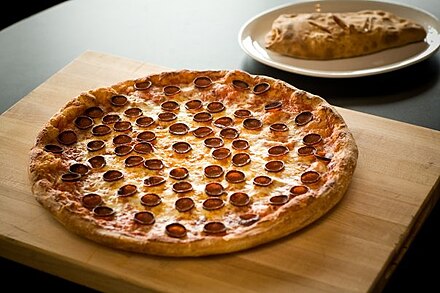
Pizzeria food
In addition to pizza, pizzerias often sell submarine sandwiches (also called heroes, grinders, hoagies and simply subs, depending on what region you are in), which are very big sandwiches, traditionally served on Italian rolls. They may contain any of the above toppings, plus chicken parmigiana, eggplant parmigiana and several other combinations. A calzone is a similar dish that's essentially a pizza folded over itself: a zeppelin-shaped shell of dough with tomato sauce, cheese, and your choice of typical pizza toppings in the middle. Many pizza places also serve bread sticks which are typically the same dough as the pizza itself in the form of a stick battered with butter and sometimes other spices. These will commonly be paired with dipping sauces such as marinara, garlic butter, or melted cheese. Also very common are garlic knots, which are much softer than bread sticks and do not normally come with toppings but are simply garlicky dough tied in a knot, seasoned generously with olive oil and sprinkled with salt, Parmesan cheese and perhaps a green herb such as parsley and baked in a pizza oven. Additionally, a type of cheese bread or garlic bread may be served as a flatbread dish based on the same dough as the pizzas. For dessert, you may see zeppoles, balls of deep-fried dough, often sweetened. Depending on context and authenticity, shops may offer other Italian cuisine, hot wings, salads, or potato dishes.
Pizzerias typically provide free condiments in shakers on tables, though you sometimes have to ask for them. Traditional condiments in North American pizzerias are garlic powder, hot pepper flakes, dried oregano, grated Parmesan cheese, and sometimes black pepper. Pizza delivery may include packets of hot pepper or Parmesan in addition to dipping sauces.
Tipping
 See also: Tipping
See also: Tipping
In North America many pizzerias deliver. While tips are usually not expected for pickup orders, dine in pizzerias may expect a tip for table service, and delivery drivers definitely expect a tip. If the delivery is made during very rough weather, such as a severe blizzard or torrential downpour, the delivery driver may expect a larger tip than normal.
Regional styles
- The New York City area has at least three different local styles. The coal-fired thin-crust style is classic but not too common, and is famously produced by Patsy's in East Harlem and Totonno's in Coney Island, among others. The gas-fired thin-crust is not quite as thin and tends to feature toppings more than the coal-fired style. A famous gourmet example is DiFara's in Midwood, not far from Brooklyn College. The typical neighborhood slice shop style is the inexpensive "everyday" kind of pizza. The crust is thicker than the other thin-crust styles, but still thinner and more easily folded than pizzas from many other parts of North America. Pies are very large, and 1 or 2 slices is plenty large enough for most people. This style can be excellent, as some slice shops go above and beyond. Joe's in Greenwich Village is one example. If you want to sound like a local, make sure that you ask for "a slice" instead of "a piece of pizza". "A slice" is one wedge of plain cheese pizza, unless you specify additional toppings.
- New Haven has its very own style of what they call "apizza" (pronounced uh-BEETZ locally). Essentially, it's like New York thin-crust pizza, but perhaps with a more highly charred crust. Mozzarella (known as "mootz") is considered a topping and must be requested, and other quite delicious and otherwise unusual toppings are used such as littleneck clams.
- Chicago has three local styles. The most widely known is the deep dish, which has a thicker, pan-fried dough, cooked in a straight-sided pan, and has sauce on top of the cheese and toppings. A stuffed pizza is similar, but after being filled with even more cheese and toppings, the pizza is closed with another layer of dough before being covered with sauce. Chicago-style thin crust has a very thin, crunchy crust and is cut into squares.
- Detroit-style pizza derives from Sicilian rather than Neopolitan pizza, and styles similar to this are often called "Sicilian" elsewhere. It's made in a rectangular pan, has a thick crisp crust similar to focaccia, and toppings such as pepperoni and mushrooms are layered in a specific way: pepperoni is placed on the bottom, followed by cheese and other toppings, and the sauce on top.
- St. Louis-style pizza comes with a very thin, cracker-like crust without yeast, Provel processed cheese, and is cut into squares or rectangles instead of wedges.
- Quad Cities-style pizza is mostly seen in the Midwest, especially on the border between Iowa and Illinois. The moderately thick crust has a nutty, malty flavor, the tomato sauce is usually spicier than average, and any toppings are placed under a layer of cheese. It is characteristically cut into rectangular strips with a pair of pizza scissors.
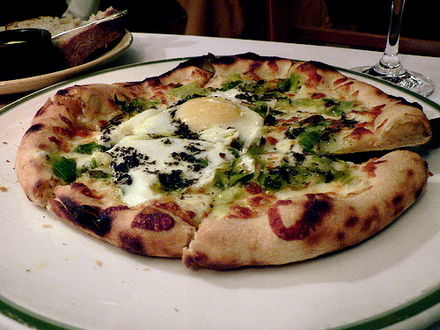
- California-style pizza is defined by its use of many non-traditional ingredients, combining fresh healthy produce with a cultural mishmash of flavors: artichoke hearts, avocado, goat cheese, and unusual sauces (like Thai peanut sauce or barbecue sauce) are just a few common toppings.
- Colorado-style pizza is hearty and sometimes includes honey as an ingredient.
- Hawaii pizza is a Canadian invention with ham and pineapple as toppings. It has since spread worldwide. However, the Canadian claim is disputed by many Germans, who point to "Toast Hawaii" with similar ingredients being shown on German TV in the 1950s, while the earliest mention of Canadian Hawaii pizza dates to the 1960s. Though pizza in general is a celebrated culinary triumph in many corners of the Internet, pineapples on pizza are an unusually controversial subject, and are often considered to be a sacrilege by Italians.
Types of pizzerias
There are several styles of pizza restaurant, serving anything from the cheapest fare to upscale cuisine.
- Hole-in-the-wall pizza dives and small locally-owned shops generally have their own unique flair and are liable to have a "signature" style—possibly with unconventional decor or unique toppings. These will be your best bet for getting pizza by the slice and are often cheapest, although many locally-owned places are finer establishments. Some have been around for decades.

- Sit-down restaurants are more likely to offer authentic Italian cuisine and are generally priciest. They usually do not offer delivery. Some fast casual chains have attempted to emulate this style, such as Blaze Pizza or MOD Pizza.
- Major chains such as Domino's, Little Caesars, Papa John's, or Pizza Hut have made their business off of fast delivery and cheap prices. Some regions have locally famous chains such as Round Table Pizza in the Western United States or California Pizza Kitchen which is mostly bi-coastal with a small string of restaurants in the central U.S.
- Take and bake stores such as Papa Murphy's offer uncooked pizza which you can design at the shop and cook at your leisure. Because these stores have no ovens and no seating, they can keep costs down, resulting in pizzas that are significantly cheaper than those from other pizzerias. Take and bake pizzas are also available from the freezer or deli section in supermarkets. This is a good option if you have access to a kitchen where you're staying.
- Delivery-only establishments are not intended for eating in and are usually very small with a waiting area that can only accommodate a few customers standing in line for take-out. In late hours or in dangerous neighborhoods, they may be locked entirely and only offer food through a slot in the door or via delivery.
- Some entertainment venues, typically catering to children, serve pizza while providing activity areas, arcades and pinball machines.
- Supermarkets and convenience stores offer frozen or fresh pizzas for off-site reheating and consumption.
- Concession stands at movie theaters, sports stadiums and amusement parks, etc. often serve pizza by the slice or personal pizzas.
Restaurants
Major national chains
While large chains guarantee a consistent experience (i.e., a pizza in the Philadelphia location of their chain will be exactly the same as in their Phoenix location), they are rather divorced from local tastes, and the best pizzas are usually to be found at independent locations or smaller chains. Nonetheless, the biggest chains with national presences or large regional presences include:
- 241 Pizza – A Canadian chain with almost 100 stores.
- Blaze Pizza – Founded in the Los Angeles area in 2011, Blaze's service (like MOD and Pieology, the other two exemplars listed below of the "big three" U.S. fast-casual pizza chains) is based on the Chipotle model, with customers choosing their own crust, sauces, and toppings, and then having the pizza baked in an open-flame oven in about 3 minutes. In terms of food quality and culinary creativity, Blaze is in the middle of the pack relative to its competitors: foodies aren't cared for quite as artfully as at MOD, but the whole cloves of roasted garlic and hand-cut basil Blaze puts in their food, for example, are a step above Pieology<nowiki>'</nowiki>s crushed processed garlic and pre-shredded basil, respectively. There's also a wider range of toppings, as well as custom main-course salads for those who may not be hungry for pizza. Blaze's geographic footprint is rapidly spreading outside its California homebase: additional locations can be found in the Northeast and Great Lakes, and a few in Canada too—two each in Calgary and Edmonton, plus one in Toronto and one in St. John's, NL.
- Boston Pizza — Founded in Edmonton, Boston Pizza is a somewhat more upscale Canadian chain, with locations in all provinces of Canada from St. John's, Newfoundland to Victoria, British Columbia, as well as Yukon and the Northwest Territories. Boston Pizza, which also operates in the U.S. as Boston's Restaurant, is designed on the business model of a restaurant with a sports bar.
.jpg/440px-Pizza_(4).jpg)
- California Pizza Kitchen – A fast-casual option mostly concentrated on the coasts with occasional outposts at airports and major city hubs. Probably best known for their white pizza.
- Chuck E. Cheese's – This chain of children's entertainment centers features pizza as its best-known and most popular menu item. Not a great option if all you want is pizza, but it's hard to beat if you also like video games and musical kiddie entertainment.
- Domino's – The largest pizza chain in the U.S. and the world, also with a major presence in Canada. Primarily a delivery chain that also offers carry-out; only a small number of locations offer dine-in.
- Fox's Pizza Den
- Gatti's Pizza – Most locations offer both delivery and sit-down, usually with an all-you-can-eat buffet.
- Godfather's Pizza – Godfather's is a medium-sized chain of restaurants similar to Pizza Hut, offering carry-out, delivery, and dine-in options. Notable for still offering a "Small" pizza in a world where Medium and Large are often your only options. They also have Mini and Jumbo sizes. Godfather's Express outlets, many of them located inside Speedway gas stations, omit the dine-in seating and have a more limited menu.
- Jet's Pizza – A Michigan-based chain with locations in 18 states (mainly in the Midwest and South) that's most famous for Detroit-style pizza. If that doesn't sound like your thing, they have regular pizzas (and even New York-style thin crust) too, as well as other pizzeria standards like garlic bread, calzones (called "Jet's Boats" here), salads and submarine sandwiches.
- Little Caesars – Some of the cheapest pizza available. Most locations are carry-out only; a few also offer delivery. Many offer a "hot and ready" option in which a few commonly-ordered pizzas (such as medium pepperoni or cheese) are pre-made and already waiting during peak times.
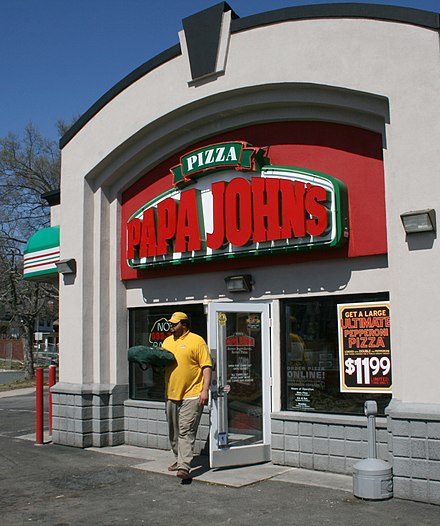
- Marco's – A rapidly growing pizza chain based out of Toledo, Ohio, now with over 800 locations in 35 states.
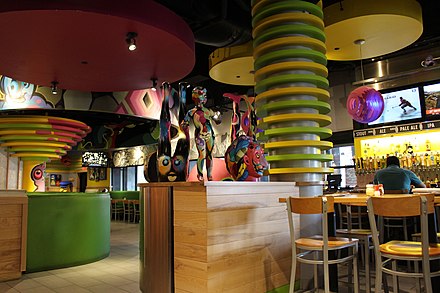
- Mellow Mushroom - A pizza chain known for funky atmosphere and unique toppings.
- MOD Pizza – The largest, oldest (founded in Seattle in 2008), and fastest-growing of the trio of fast-casual pizza chains to emerge at the dawn of the 21st century (the others being Blaze and Pieology), with 200+ locations across the country but especially along the Mid-Atlantic coast, in the Chicago, Detroit, and Phoenix areas, in Texas, and (above all) splayed along the Interstate 5 corridor on the U.S. West Coast. By comparison with the competition, MOD's emphasis on fresh, high-quality ingredients and relatively more upscale preparation (for instance, all dough is made fresh in-house daily, and ingredients are sourced sustainably from eco-conscious suppliers) gives it the strongest claim to the coveted "artisanal" buzzword all three chains employ heavily. Though you can build your own pizza at MOD, the menu here also places more emphasis on their selection of ten specialty pizzas (augmented by a changing seasonal selection or two). Order "double crust" (a nominal upcharge) for the closest thing to Chicago-style deep dish you can find anywhere in the fast-food world. Outside the realm of pizza, build-your-own salads following a similar Chipotle-style service model are offered, or you can enjoy a "pizza salad" served on a warm asiago crust.
- Papa John's – Essentially the same business model as Domino's (delivery and carry-out, with only a tiny number of dine-in locations). Heavily boasts about the quality of its ingredients in its advertising, but your mileage may (and almost certainly will) vary.
- Papa Murphy's – A chain based in Vancouver, Washington, specializing in take and bake pizzas.
- Pieology – Largely seen as a poor man's MOD or Blaze—the same basic concept except fewer topping choices and cheaper-quality ingredients—Pieology redeems itself somewhat by offering a selection of "After Bakes", or optional toppings that can be added to your pizza after it comes out of the oven: everything from barbeque sauce to roasted red peppers to an olive-oil drizzle. As well, if you like your pizza well-done, Pieology may be the fast-casual option for you: pizzas are cooked for a full five minutes, making for a nice crispy texture. You'll find Pieology in basically the same geographic area as Blaze, but even more heavily concentrated in California.
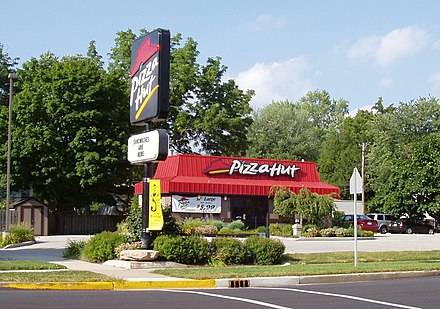
- Pizza Hut – The second-largest pizza chain in the U.S. and the world, known for their Pan Pizza, baked in cast-iron pans. They also have a thin, crispy crust and a hand-tossed style crust. They even will stuff a crust with cheese. All Pizza Huts offer carry-out, and the vast majority offer delivery. The all-you-can-eat lunch buffet (weekdays only) is a great way to sample several different types of pizza, which makes Pizza Hut a great place to go if your goal is eating classic American pizza. Most locations have waitstaff and plenty of seating; Pizza Hut Express locations have no table service.
- Pizza Pizza – A Canadian chain established in Toronto in the 1960s but now increasingly found in other parts of the country. Unlike Pizza Hut (which is a sit-down restaurant), these are bright-orange takeaway counters with a limited, if any, seating area. Famous for two things—extensive advertising of one central number city-wide for delivery (which traditionally ends in "-1111", originally sung ad infinitum on Toronto radio as "nine six seven, eleven eleven, call Pizza Pizza, hey hey hey!") and a name which ensures Little Caesars can't use its "Pizza! Pizza!" slogan in Canada. Available in Yukon and all provinces but Newfoundland and Labrador as of 2022. (Alberta is mostly served by Pizza 73; see below for details.)
- Sbarro – Sbarro is almost universally derided as the bottom of the pizza barrel: descriptors in a particularly uncharitable Slate article included "America's least essential restaurant", "devoid of atmosphere, charm, and gustatory relevance", and "Sboring". However, its status as by far the largest fast-food Italian chain (800 locations worldwide; in North America you'll find them mostly in shopping malls, highway rest stops, and airport terminals) means that if you absolutely need a fix and aren't in an area served by Blaze, MOD, or Pieology, Sbarro may be the only game in town. Is the food really that bad, though? Consensus says it's hit-and-miss, but in the best-case scenario the New York-style pizza by the slice that's Sbarro's stock in trade gets the job done sufficiently if not particularly artfully (the crust is even thin enough to fold!) Other options include thicker-crust, Sicilian-style "double duo pepperoni" slices, stromboli, and a few pasta dishes. Locations are spread out all over the U.S. and Canada (yes, that includes New York City, where pizza diehards scoff at Sbarro's food yet the Times Square location is reliably packed with tourists!)
- Uno Pizzeria & Grill – The original Pizzeria Uno in Chicago is the birthplace of Chicago-style deep-dish pizza; Uno Pizzeria & Grill is the nationwide franchised version of the original eatery. In addition to deep dish pizza, Uno has a large menu of American and Italian-American dishes and features a full bar.
- Villa Italian Kitchen – With a history that stretches back to 1964, when Italian immigrant Michele Sciotto opened the original Villa Pizza in midtown Manhattan next door to the Ed Sullivan Theater, you'll find this fast-casual chain spread out in over 300 non-freestanding locations across the U.S.—shopping mall food courts, university dining halls, highway rest stops. While pizza remains the cornerstone of Villa's menu (the various selections come in regular, Neapolitan-style, or thicker-crust pan pizzas) as well as stromboli and other pizza-adjacent specialties, you can also get a variety of pasta dishes and main-course salads.
Regional chains
- Abby's Legendary Pizza – since 1964 in Oregon and Washington

- Buddy's Pizza – since 1946 in Metro Detroit
- Greco Pizza – Regional chain in Atlantic Canada based in Halifax that is similar to Domino's or Pizza Pizza (see above). Known for their phone number jingle ("310-3030"). Also serves Halifax donairs, similar to fellow regional chain Pizza Delight (see below).
- Grotto Pizza – since 1960 in Delaware and parts of Maryland and Pennsylvania
- Marion's Piazza – since 1965 in Dayton area
- Papa Gino's – since 1961 in New England
- Pi Co. – Ontario's answer to MOD or Blaze Pizza, this chain, founded in Toronto in 2016, has locations in the Greater Toronto Area, Hamilton, Kitchener, and Ottawa, along with a small cluster in Saskatchewan located in Saskatoon.
- Pizza Delight – Eastern Canada's homegrown competitor to Pizza Hut (see above), based in Moncton, New Brunswick, with locations all over the Maritimes and Newfoundland and Labrador, as well as a sizable cluster of Southwestern Ontario outlets stretching from Muskoka south to the London area—mostly sit-down restaurants, but there are some smaller locations (including all those in Ontario) that offer pickup and delivery only. You'll find the usual panoply of specialty and build-your-own pizzas, panzerotti, garlic bread, and pasta dishes as well as a modest selection of chicken and seafood mains. Specialties include a grill-your-own bread bar with a variety of spreads to choose from, as well as donair, a Canadian East Coast specialty that's basically a North Americanized interpretation of the Turkish döner kebab, served in a pita wrap (here they're also available as a pizza topping).
- Pizza 73 – Western Canada's version of Pizza Pizza (above), and owned by that company since 2007. Founded in Edmonton in 1985, it has about 90 locations throughout Alberta, British Columbia, and Saskatchewan.
- Pizzaville – since 1963 in the Greater Toronto Area
- Western Pizza – started in Regina, Saskatchewan; available in Saskatchewan and southern Alberta